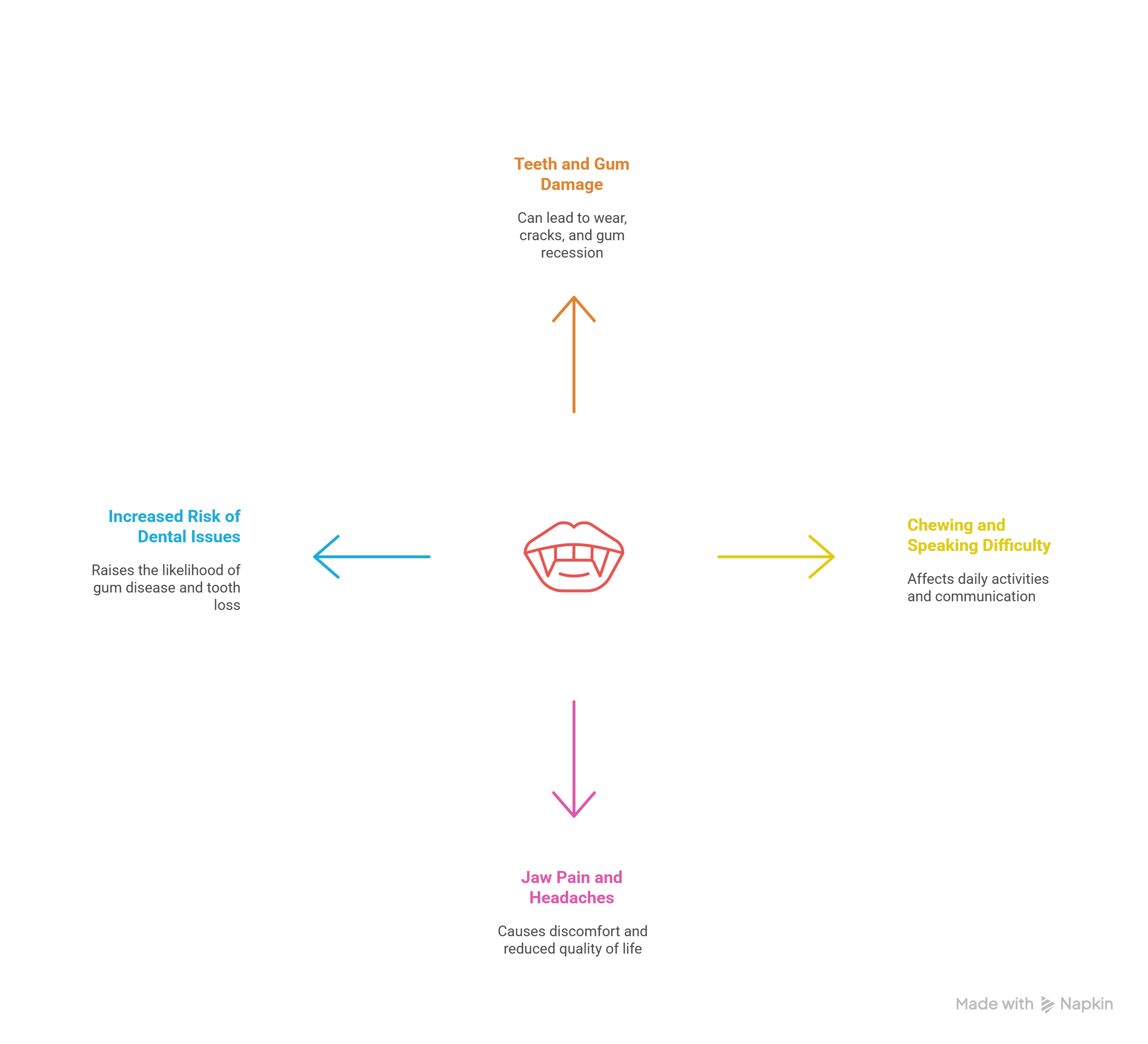What Is an Overbite?
In orthodontics, the term “bite” typically describes how the upper and lower jaws align with each other. It’s crucial for overall oral health, especially in the context of periodontal health and dental implants.
What Is Considered a Normal Overbite?
An overbite occurs when the upper front teeth extend beyond the lower front teeth. A slight overlap of about 1 to 2 millimeters is considered normal and plays an essential role in proper dental function, including the alignment of the gums and teeth.
Misalignments, especially if left untreated, can lead to gum recession, which can affect the stability of dental implants and surrounding periodontal structures.
Types of Overbites
 Skeletal Overbite
Skeletal Overbite
Caused by irregular jawbone growth. This can contribute to periodontal issues due to abnormal pressure on the gum tissues and bone structure, affecting the long-term success of dental implants.
Dental Overbite
Caused by external factors such as lack of oral space or bad oral habits. This type of overbite is commonly treated with advanced periodontal techniques to ensure that the gums remain healthy and dental implants are supported properly.
Mixed Overbite
A combination of skeletal and dental factors. Both types can impact gum health, leading to conditions like gum recession, which can necessitate procedures like gum grafting or sinus lifts.
The severity of an overbite is measured by the percentage of teeth overlapping. Mild overbites (30%) may not require treatment, but severe overbites (100%) require orthodontic intervention or surgery. Severe overbites can cause bone loss in the jaw, making implant procedures more challenging.
| Type of Overbite | Extent | Cause | Severity Percentage | Impact on Periodontal Health |
|---|---|---|---|---|
| Normal | 1 to 3 millimeters | Usually dental | 30% | Can affect gum health over time |
| Deep | 4 to 8 millimeters | Dental or skeletal | 50% | Can lead to gum recession and implant complications |
| Severe | 9 millimeters or more | Dental or skeletal | 100% | Can damage gums and bone, complicating dental implant success |
Difference between Overbite and Overjet
An overbite differs from an overjet in its vertical misalignment, while an overjet is a horizontal discrepancy between the teeth.
Overbites can lead to further gum issues like recession or bone loss, which could complicate dental treatments like implants. Proper management of an overbite prevents these complications, particularly in patients with dental implants.
Causes of an Overbite

Genetics:
Genetics plays a role in the development of a skeletal overbite, where jawbone development is irregular. Skeletal overbites may complicate dental implant procedures by affecting the alignment and stability of the gums.
Crowding of Teeth:
When there’s insufficient space for the teeth, they shift into abnormal positions, which can cause an overbite. This often leads to gum irritation and, over time, gum recession. Proper periodontal treatments can help manage these changes.
External Factors:
External factors like thumb sucking or prolonged pacifier use can result in dental misalignment, leading to an overbite. These behaviors can also compromise gum health, making procedures like gum recession repair or lip repositioning necessary.
Complications of an Untreated Overbite

An untreated overbite can progressively worsen, leading to permanent damage to your teeth, bones, and jaw structure. If left untreated, it can lead to gum disease (periodontitis), affecting not just the appearance but the functionality of dental implants as well. It’s essential to address these concerns early, especially in cases involving dental implants.
Untreated overbite complications:
- Damage to your gums and bone structures, making future dental implant placement difficult.
- Difficulty chewing and speaking.
- Jaw pain and headaches, leading to further periodontal complications.
- Increased risk of gum disease, tooth decay, and eventual tooth loss.
Remember that orthodontic treatment is essential for maintaining not only aesthetic alignment but also the health of your gums and implants.
How is an Overbite Fixed?
American Association of Orthodontists (AAO)
“Orthodontic treatment can help correct misaligned teeth and improve both function and aesthetics. Overbites, when left untreated, can lead to significant dental problems including jaw pain, tooth wear, and difficulty chewing.”
Orthodontic treatment can correct misaligned teeth and improve both function and aesthetics. Overbites, when left untreated, can lead to significant dental problems including damage to the gums and complications in implant procedures.
- Metal or ceramic braces: Metal braces can straighten teeth and adjust the alignment. Proper alignment can prevent unnecessary stress on the gums, which is crucial for dental implant stability.
- Invisalign Clear Aligners: These are an effective option for correcting mild to moderate overbites. For patients with implants, Invisalign aligners help maintain the gum contour around implants.
- Surgery: In severe cases, oral surgery combined with orthodontic treatment is necessary. This could also include procedures like ridge augmentation or bone grafting to ensure the jawbone is healthy enough to support implants.
- Retainers: Retainers help maintain the results achieved from orthodontic treatment and prevent teeth from shifting. Retainers are critical in preserving the health of your gums and preventing implant displacement.
FAQ
What does an Overbite Look Like?
An overbite occurs when the upper teeth extend beyond the lower teeth, causing a noticeable vertical misalignment. This misalignment can compromise gum health and complicate the placement and maintenance of dental implants.
How to Fix Overbite Naturally?
While natural remedies like tongue posture and jaw exercises can help with mild cases, moderate to severe overbites often require professional orthodontic care. Early intervention can prevent the need for complex periodontal treatments and enhance the success of future dental implants.
Conclusion
An overbite is more than just a cosmetic issue; it can have long-term effects on periodontal health and the success of dental implants. Proper treatment, whether through orthodontics or periodontal surgery, is essential for preserving both functional and aesthetic oral health.
Sources:
https://www.aaoinfo.org/

